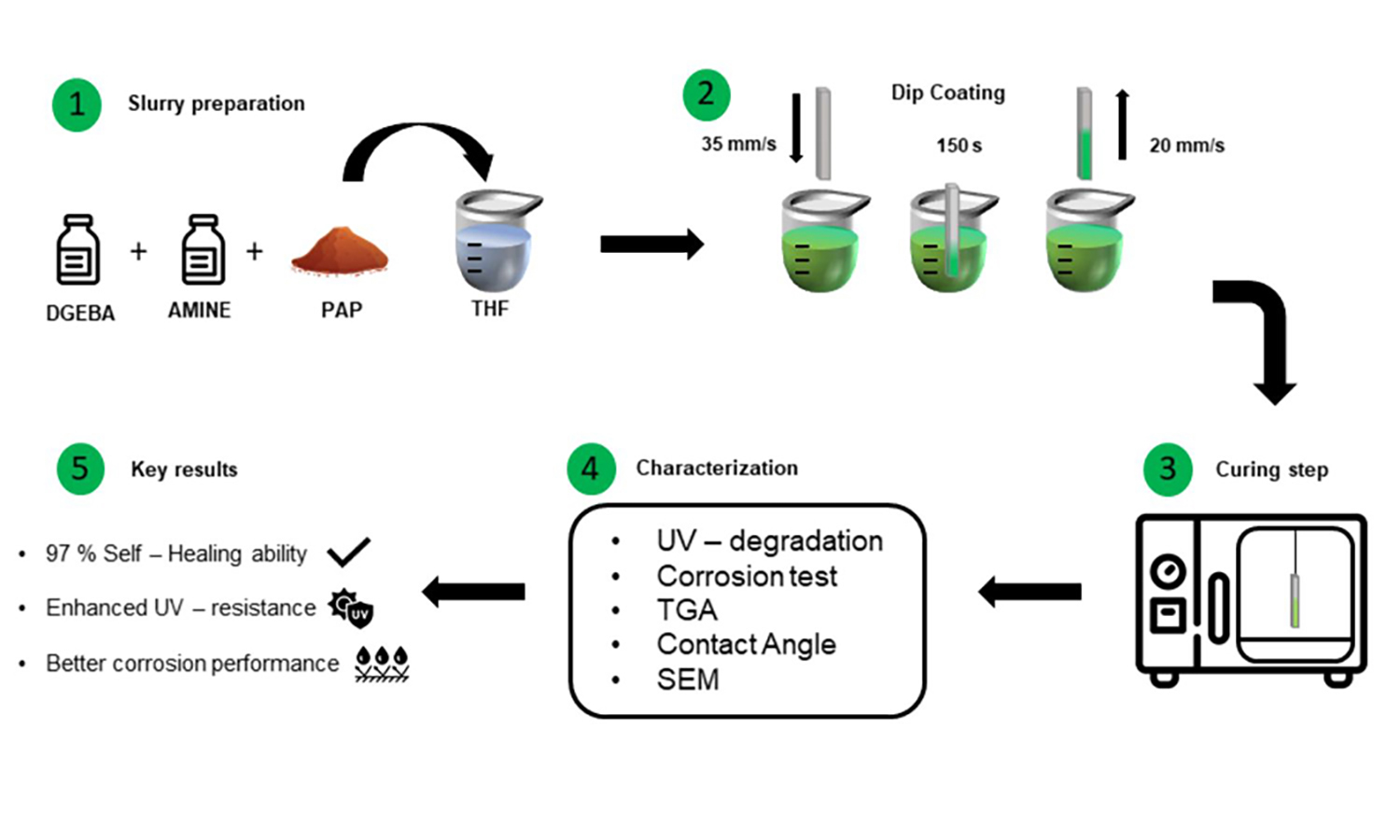Recyclable epoxy-amine coating modified with an azobenzene for light-activated damage repair and enhanced degradation resistance
Juan Pablo Caclamanis, Gabriela Clarisa Campos, Ileana Zucchi, Silvia Cere, María José Galante, Valeria Pettarin
Vol. 19., No.11., Pages 1188-1201, 2025
DOI: 10.3144/expresspolymlett.2025.87
DOI: 10.3144/expresspolymlett.2025.87
GRAPHICAL ABSTRACT

ABSTRACT
An epoxy-amine coating modified with 4-phenylazophenol (PAP) was developed on a steel substrate to promote self-healing capabilities. The self-healing mechanism is driven by light-induced trans–cis isomerization of the azobenzene moiety, enabling localized mobility of the polymer network and restoring surface integrity without thermal activation. The proposed epoxy–amine system combines thermoplastic-like processability with crosslinked mechanical stability, while its reversible physical crosslinks enable efficient recycling upon heating above the gel–liquid transition temperature. Furthermore, it was found that the modified coating enhanced corrosion resistance, UV stability, and durability. Electrochemical impedance spectroscopy (EIS) revealed higher low-frequency impedance values for PAP-epoxy, while Tafel analysis showed a significant reduction in corrosion current density, confirming enhanced anticorrosive performance. Compared to the unmodified epoxy system, PAP-epoxy exhibited reduced porosity and crack density, as well as more tortuous microcrack paths, thereby improving its barrier properties. The combined use of FTIR, TGA, and contact angle measurements demonstrated that PAP incorporation delayed the formation of oxidative degradation products and preserved thermal stability after prolonged UV exposure. The improved protective performance is attributed to the combined effects of microstructural refinement, reduced porosity, and UV-absorbing capability of PAP.
RELATED ARTICLES
Ming Qiu Zhang
Vol. 18., No.6., Pages 559-560, 2024
DOI: 10.3144/expresspolymlett.2024.41
Vol. 18., No.6., Pages 559-560, 2024
DOI: 10.3144/expresspolymlett.2024.41

This is an editorial article. It has no abstract.
Aina Perez-Nakai, Alejandro Lerma-Canto, Acerina Trejo-Machín, Iván Dominguez-Candela, Jose Miguel Ferri, Vicent Fombuena
Vol. 17., No.12., Pages 1224-1238, 2023
DOI: 10.3144/expresspolymlett.2023.93
Vol. 17., No.12., Pages 1224-1238, 2023
DOI: 10.3144/expresspolymlett.2023.93

The present work describes, for the first time, the chemical modification and characterization of epoxy resins derived from Brazil nut oil (BNO). The development of a bio-based resin has been carried out by chemically modifying BNO, resulting in epoxidized Brazil nut oil (EBNO). Moreover, through a maleinization process, a crosslinker based on maleinized Brazil nut oil (MBNO) has been employed. Analysis using techniques like iodine value (IV) and oxirane oxygen content (Oo) indicate successful chemical modification. FTIR analysis confirms the presence of reactive functional groups in both EBNO and MBNO, which are responsible for resin crosslinking. Mechanical testing of the different bio-resins developed shows that, in the cured resins, flexural strength and modulus decrease with increasing MBNO content, indicating improved flexibility due to the introduction of MBNO as a crosslinker. Thermal analysis using differential scanning calorimetry (DSC) reveals exothermic peaks corresponding to resin curing appearing at progressively lower temperatures. Therefore, this study successfully modifies BNO and demonstrates its effectiveness as a precursor to develop bio-based epoxy resins. The resulting resins exhibit improved ductile and thermal properties, making them suitable for various applications requiring low mechanical stresses.



